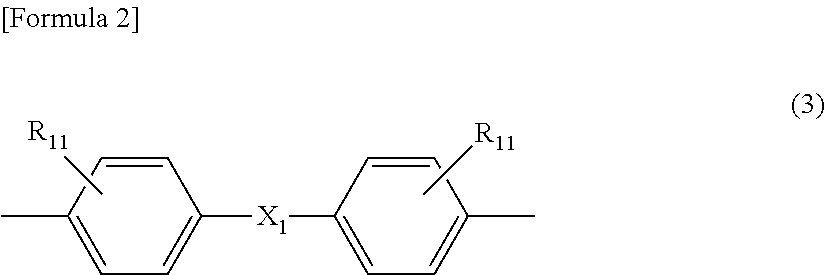Polycarbonate copolymer, coating liquid using same, molded body, and electrophotographic photosensitive body
a technology of polycarbonate copolymer and coating liquid, which is applied in the direction of electrographic process, coating, instruments, etc., can solve the problems of increasing the wear volume of the electrophotographic photoreceptor, deteriorating resin, etc., and achieves the effects of reducing residual potential, reducing fatigue, and enhancing sensitivity
- Summary
- Abstract
- Description
- Claims
- Application Information
AI Technical Summary
Benefits of technology
Problems solved by technology
Method used
Image
Examples
manufacturing example 1
Synthesis of OC-BP Oligomer (Bischloroformate)
[0140]150.0 g (0.701 mol) of 3,3′-dimethyl-4,4′-biphenol (OC-BP) was suspended in 1100 mL of methylene chloride, to which 186 g (1.88 mol) of phosgene was added to be dissolved. Into this obtained solution, a solution in which 199.4 g (1.97 mol) of triethylamine was dissolved in 460 mL of methylene chloride was dropped at 13 degrees C. to 16 degrees C. for 2 hours and 50 minutes. The reactant mixture was stirred at 14 degrees C. to 16 degrees C. for 30 minutes. 5.0 mL of concentrated hydrochloric acid and 200 mL of deionized water were added to the reactant mixture for cleaning. Subsequently, cleaning with water was repeated until an aqueous layer becomes neutral. Thus, a methylene chloride solution of an OC-BP oligomer having a chloroformate group at its molecular end was obtained. The obtained solution had a chloroformate concentration of 0.58 mol / L, a solid concentration of 0.01 kg / L and an average number of monomer units of 1.06. Thi...
manufacturing example 2
Synthesis of DMDPE Oligomer (Bischloroformate)
[0143]Into a mixed solution containing 160.0 g (0.695 mol) of bis(3-methyl-4-hydroxyphenyl)ether (DMDPE), 1020 mL of methylene chloride and 187 g (1.89 mol) of phosgene, a solution prepared by diluting 199.4 g (1.97 mol) of triethylamine in 460 mL of methylene chloride was dropped at 13 degrees C. to 16 degrees C. for 3 hours and 6 minutes. The reactant mixture was stirred at 14 degrees C. to 16 degrees C. for 1 hour and 38 minutes. 5.0 mL of concentrated hydrochloric acid and 200 mL of deionized water were added to the reactant mixture for cleaning. Subsequently, cleaning with water was repeated until an aqueous layer becomes neutral. Thus, a methylene chloride solution of a DMDPE oligomer having a chloroformate group at its molecular end was obtained.
[0144]The obtained solution had a chloroformate concentration of 1.04 mol / L, a solid concentration of 0.18 kg / L and an average number of monomer units of 1.07. This material obtained in Ma...
manufacturing example 3
Synthesis of DE-BP Oligomer (Bischloroformate)
[0145]150.0 g (0.620 mol) of 3,3′-diethyl-4,4′-biphenol (DE-BP) was suspended in 1100 mL of methylene chloride, to which 186 g (1.88 mol) of phosgene was added to be dissolved. Into this obtained solution, a solution in which 199.4 g (1.97 mol) of triethylamine was dissolved in 460 mL of methylene chloride was dropped at 13 degrees C. to 16 degrees C. for 2 hours and 50 minutes. The reactant mixture was stirred at 14 degrees C. to 16 degrees C. for 30 minutes. 5.0 mL of concentrated hydrochloric acid and 200 mL of deionized water were added to the reactant mixture for cleaning. Subsequently, cleaning with water was repeated until an aqueous layer becomes neutral. Thus, a methylene chloride solution of an DE-BP oligomer having a chloroformate group at its molecular end was obtained. The obtained solution had a chloroformate concentration of 0.57 mol / L, a solid concentration of 0.01 kg / L and an average number of monomer units of 1.06. This...
PUM
| Property | Measurement | Unit |
|---|---|---|
| mole percentage | aaaaa | aaaaa |
| mole percentage | aaaaa | aaaaa |
| mole percentage | aaaaa | aaaaa |
Abstract
Description
Claims
Application Information
 Login to View More
Login to View More - R&D
- Intellectual Property
- Life Sciences
- Materials
- Tech Scout
- Unparalleled Data Quality
- Higher Quality Content
- 60% Fewer Hallucinations
Browse by: Latest US Patents, China's latest patents, Technical Efficacy Thesaurus, Application Domain, Technology Topic, Popular Technical Reports.
© 2025 PatSnap. All rights reserved.Legal|Privacy policy|Modern Slavery Act Transparency Statement|Sitemap|About US| Contact US: help@patsnap.com



